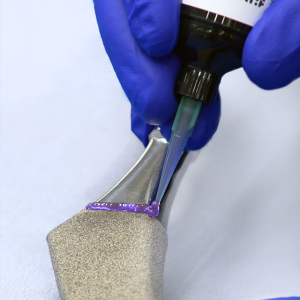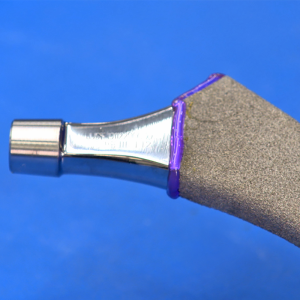Approximately 200,000 people receive hip or knee replacements in England and Wales every year, and these are typically highly effective. Research from the University of Bristol found that eight out of ten knee implants and six out of ten hip replacements last up to 25 years. To ensure long term success, orthopaedic implants must be precisely manufactured to specific surface finishes to achieve the required biological, chemical, and mechanical properties — for example, to reduce friction and wear.
Orthopaedic implant manufacturers typically achieve the desired surface finishes with multiple steps of processing. During these steps, maskants are applied to protect certain surfaces from processes like anodization, plasma treatment, or shot blasting, while applying them to the surfaces that remain exposed. Once the process has taken place, the mask is removed, typically via peeling, which may require soaking in water to soften the material, or incineration, and further masks can then be added where needed as the product moves through different processing steps.
Approaches to temporary masking

Traditional approaches to implant masking include tapes, boots, waxes, and lacquers. However, each of these techniques comes with benefits and challenges. Because orthopaedic implants are typically in complex geometries, masking accurately with boots and tapes is difficult and time consuming. Another challenge with boots and tapes is that they may deform — for example, if the edges of the tape lift, it can result in suboptimal edge definition. Applying these materials is typically done manually, which can be time consuming and subject to human error.
These challenges can be overcome by using a liquid mask, such as a lacquer or wax. If they have a low viscosity, they can be hard to accurately apply, and can drip or flow into additional areas of the implant, leading to poor edge definition. Alongside this, their cooling or curing time can take minutes to hours, and can create work in process, slowing down manufacturing.
If there is a problem during the masking process, such as the edges of the tape lifting, the mask being applied in the wrong place, or the mask not being tacked down correctly, there is the potential for rework or scrap. Implants are high value parts, and avoiding this is therefore of the utmost importance for manufacturing profitability.
Benefits of UV curable materials
UV curable liquid masks are a compelling option for masking orthopaedic implants. Their process speed and simplicity leads to increases in productivity, while overcoming the challenges associated with traditional masking approaches — they can reduce labour, rework, and scrap.
One of the key reasons for this is that UV curable materials cure “on demand”, typically in seconds. Because the material will not cure until exposed to the correct wavelength and intensity of UV light, the manufacturer can be highly precise. If the process is inaccurate for some reason, the manufacturer can easily wipe off the material and start again. The rapid cure time also means the masked implant can be moved immediately into the next stage of processing, reducing work in progress.
Building a masking process

There are a wide variety of UV curable masking materials available, in low, medium, and high viscosity formulations, and with varying adhesion properties, so manufacturers can choose a material that suits their application. For example, Dymax SpeedMask is a popular option for orthopaedic implant masking, and is available in burn off and peelable grades to leave surfaces residue free. These materials conform to complex shapes, providing reliable coverage in a single layer, eliminating time taken to wait for layers to dry.
UV curable materials are single component and solvent free, meaning they are easy and safe to handle, with no mixing. Depending on the requirements of the application, UV curable materials can be dispensed with varying levels of precision, from simple time pressure dispensing up to volumetric dispensing, such as using the preeflow® eco-PEN, which offers an accuracy of ±1%, >99% of the time. For complex geometries or surfaces with variation, manufacturers may wish to consider contactless applications using jetting valves or by spraying. Application is more readily automatable than other options, further reducing the risk of application errors.
It is important to note when choosing a UV curable material that, for optimum results, it must be matched with an appropriate UV curing system. LED curing systems bring many benefits over traditional mercury arc systems, particularly in their reduced energy consumption. They require no warm-up and cool down time, so users can turn them on and off on demand for instant use. In addition, there is no need to change bulbs, which can further add to cost savings over time.
To confirm cure, some materials, such as Dymax 726-C, contain a colour change technology that means the mask is dispensed blue and cures pink, for an added safety factor.
Orthopaedic implant surgeries are typically highly effective, and maintaining an accurate, productive manufacturing process is key to ensuring that patients can receive the treatment they need. With UV curable masing materials, manufacturers can overcome the challenges associated with other techniques, helping to produce accurate implants more efficiently.
Tell us about your application ideas for this durable, effective product.
